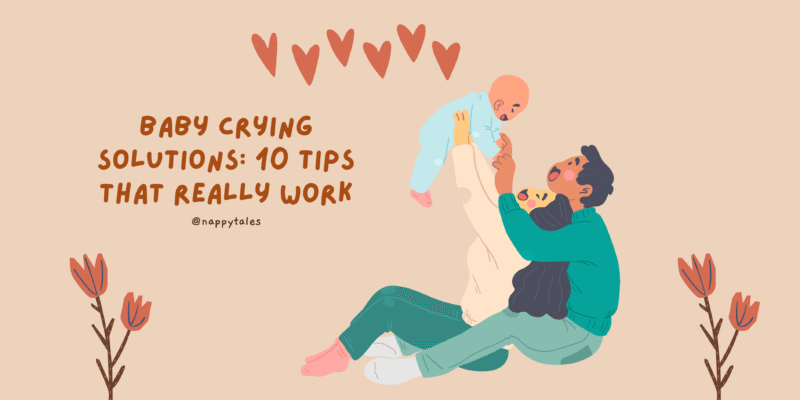How to Calm a Crying Baby (10 Proven Ways)
Crying is how babies communicate—whether they’re hungry, tired, uncomfortable, or just want to be held. But for new parents and single parents, the sound of a crying baby can be overwhelming, especially when you’re trying everything and nothing seems to work. The good news is, you’re not alone—and there are effective methods to soothe a crying baby.
In this blog post, we’ll share 10 proven, expert-backed baby calming tips that can help bring peace back into your home.

1. Check for Basic Needs First
Before diving into soothing techniques, always make sure your baby’s basic needs are met:
-
Is your baby hungry?
-
Does the diaper need changing?
-
Is the baby too hot or too cold?
-
Is the clothing irritating the skin?
Often, a crying spell is simply your baby trying to get your attention for one of these reasons. Addressing these needs first is the quickest way to soothe a crying baby.
2. Use Swaddling to Recreate the Womb
Swaddling is an age-old technique where you snugly wrap your baby in a soft blanket, helping them feel secure and comforted.
Why it works:
Swaddling mimics the tight, warm environment of the womb and reduces the startle reflex, which often causes babies to wake and cry.
Tip: Use breathable cotton swaddles and avoid over-tightening around the hips.
3. Try the “5 S’s” Method
Renowned pediatrician Dr. Harvey Karp developed the “5 S’s” for calming babies:
-
Swaddle
-
Side or stomach position (only for soothing, not for sleep)
-
Shush (use white noise or “shhh” sounds)
-
Swing (gentle rocking motions)
-
Suck (offer a pacifier or clean finger)
Combining these techniques often works wonders, especially during fussy evenings.
4. Rock or Sway Gently
Babies are used to constant motion inside the womb. Gentle rocking in a chair or using a baby swing or carrier can provide soothing, rhythmic motion that helps calm your baby.
Bonus Tip:
Try walking while holding your baby in your arms or in a carrier. The motion, combined with your heartbeat, can be deeply reassuring.
5. Use White Noise or Gentle Sounds
White noise machines, vacuum cleaners, or calming lullabies can block out external stimuli and mimic the whooshing sounds of the womb.
Best Options:
-
Portable white noise machines
-
YouTube lullabies or mobile apps
-
Soft instrumental music
Adding soothing background sounds is one of the easiest and most effective baby calming tips, especially during naps and bedtime.
6. Offer Skin-to-Skin Contact
Skin-to-skin contact is incredibly powerful for both parent and baby. It helps regulate the baby’s body temperature, heart rate, and even stress hormones.
How to do it:
Place your baby (wearing only a diaper) on your bare chest. Cover with a soft blanket. This bonding technique not only calms crying but promotes long-term emotional connection.
7. Try Feeding (Even if Just Fed)
Sometimes, babies cry even if they’ve recently eaten. This could be due to a need for comfort sucking, a growth spurt, or even mild reflux.
If breastfeeding, try offering the breast again. If bottle-feeding, check if the nipple flow is appropriate and if the baby is swallowing too much air.
8. Massage and Gentle Tummy Rubs
A gentle massage can help relax your baby’s muscles and release gas that may be causing discomfort.
How to Massage:
-
Use baby-safe oil or lotion
-
Gently rub the back, arms, legs, and belly in circular motions
-
Avoid pressing too hard—your touch should be soft and soothing
Tummy massages can also help with colic and gas pains—two common reasons babies cry.
9. Take a Walk Outdoors
Fresh air, natural sounds, and a change of environment can help distract and calm a fussy baby. Even a short stroll in a stroller or carrier can make a big difference.
For single parents, this also offers a chance to reset and take a mental break, which is essential for managing stress and exhaustion.
10. Stay Calm and Regulate Your Own Emotions
Babies are incredibly intuitive—they can sense your mood. If you’re stressed, anxious, or frustrated, your baby may pick up on those emotions and cry even more.
What to do:
-
Take a few deep breaths
-
Put your baby down in a safe place (like a crib) for a few minutes
-
Call a friend, family member, or support line if you’re feeling overwhelmed
A calm parent is often the best way to soothe a crying baby.
When to Worry: Crying That May Signal a Medical Issue
Sometimes, persistent crying may indicate something more serious like:
-
Ear infections
-
Allergies or intolerances
-
Acid reflux
-
Illness or fever
If your baby cries for more than three hours a day for three days a week or more (also known as colic), or if you notice unusual symptoms (vomiting, fever, rash, etc.), consult your pediatrician.
Final Thoughts for New and Single Parents
Being a new parent—especially on your own—is tough. It’s completely normal to feel overwhelmed when your baby won’t stop crying. Just remember: this phase will pass. The techniques above are all safe, science-backed baby calming tips that can help you get through even the roughest nights.
You’re doing an incredible job. Be gentle with yourself, and know that every parent, new or experienced, has been there.
